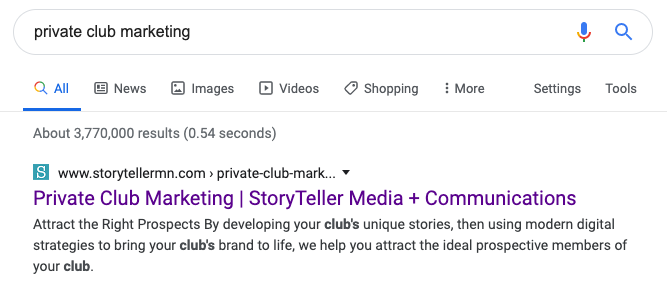A Compelling Title
Because a blog post’s title is the first thing people will see, it should clearly indicate what the article is about. Clear, specific titles attract readers and prompt them to share the post with their networks.
If you’re reading this guide, chances are good that you’re either a Membership Director or General Manager or Board Member who understands the importance of digital marketing today.
You “get” that traditional club marketing methods are both ineffective and expensive, and member referrals are unreliable. By neglecting to elevate your clubs online presence, you’re missing out on the powerful results that an effective online marketing strategy can bring about.
Whether your club is just getting started with digital marketing, you want to expand your online efforts, or you want to learn how your social media posts can result in new members and not just “likes”, this guide provides step-by-step instructions to help you set up and implement a successful online marketing strategy.
From optimizing your website for search to developing engaging content to attracting prospective members through social media to analyzing and refining your strategies, this comprehensive guide will lead you through every essential step you should take to effectively market your club online

Too often private clubs create websites that are ...

Now that you’ve optimized your website, it’s time ...

In order to get your video project ...

By this point, you ...

Lead nurturing is the process of ...

Your goal in this step is to identify your most ...
Too often private clubs create websites that are essentially a digital version of their club brochure. By doing so, they fail to differentiate themselves from other clubs in their area and they miss a massive opportunity to share their unique culture and attract the right prospective members.
Most club websites are created by technology companies with platforms that support club operations, member experience, and internal communications. Most of these websites are not designed with the intent of attracting and converting new members. If you really want to attract visitors (and potential members) to your club’s website, you need to do more than simply build it: you need to optimize it.
Search engine optimization (SEO) is how your website is discovered via search engines like Google, Yahoo, and Bing.
SEO typically involves two sets of tactics: on-page SEO and off-page SEO. On-page SEO is strategically implementing keywords on your website, through the deliberate and strategic use of page titles, headers, meta descriptions, image data and more.
Off-page SEO is the process of improving your website’s overall search engine authority, which is determined by other websites that link to your website. The goal of off-page SEO is to attract “backlinks” from relevant, authoritative websites.
While on-page and off-page SEO are helpful concepts, they are rooted in an older approach to keywords. In today’s online landscape, modern search engines are getting smarter every day. They can no longer be “gamed” through keyword manipulation. Instead, search engines reward websites (through higher search results) that provide relevant, high-quality content.
So modern SEO is about optimizing for the people searching for information, not the search engines. And the first step is making sure you have the SEO fundamentals in place.
Most modern websites are built on a platform that allows you to easily access and change your metadata, which is essential to SEO. If you are unable to make these changes yourself, you will need to contact your web developer to make the changes for you.
A page title is the text you see at the top of your browser window when viewing a web page. It’s also the title of a page that is presented in search engine results.

Page titles can be found and edited in your site’s HTML. The text that is surrounded with the <title> tag is the title of the page. Here are a few guidelines for coming up with effective page titles:
Write page titles that describe and align with the content of the page.
Write page titles that describe and align with the content of the page.
Include relevant keywords, which will happen naturally if you follow the first tip.
Put keywords as close to the beginning of the title as possible.
Make the title fewer than 70 characters long. Longer page titles will be cut off by web browsers and in search results. If the page title is too long, it will also dilute the importance of the keywords.
Include your company name at the end of the page title, unless you are a big brand and people search for you through your brand name.
Use unique page titles for each page. Each page provides an opportunity to target specific keywords.
A meta description is a short summary that describes the content of a web page. Search engines display this short description of the page beneath each result.
"Attract the right prospects by developing your club's unique stories, then using modern digital strategies to bring your club's brand to life, we help you attract the ideal prospective members of your club."
These descriptions don’t influence search engine rankings, but they are still extremely influential in enticing searchers to click your link in search results. Therefore your meta description should be compelling copy that accurately describes what’s on a page.
If certain text appears larger or more prominent than the other text on a page, it’s probably a heading. To verify this, check the HTML code of your website and look for text with an <h1>, <h2>, or <h3> tag surrounding it.
Search engines and searchers are more likely to pay attention to headings compared to regular paragraph text.
Keep in mind that <h1> tags give the text more weight as keywords than <h2> or <h3> tags. Including too many headings dilutes the importance of keywords in other headings, so we recommend using the <h1> tag only once. If the page is text-heavy, like a blog post, then feel free to throw in a few <h2> or <h3> tags as paragraph titles.
Thoughtfully selected images, particularly those that reflect your club, can enhance user experience.
Don’t use images excessively. More pictures may cause the page to take longer to load. Slow loading pages negatively impact both the user’s experience and SEO.
Associate text with pictures. For various reasons, at times the images on your site may not be displayed. Use an “alt text” HTML attribute to provide an accurate text description of the image, ensuring that site visitors will understand the information you’re presenting even if the image doesn’t render.
Include keywords in your image file name. This will help you attract relevant traffic from image searches. Separate the words in the file name with a dash (-).
The URL of a web page is its web address. For example, StoryTeller’s Crushing Club Marketing blog has a URL of https://blog.storytellermn.com/ccm. URL structure indicates how the text in a URL is organized and how the URLs on your website interact. If your website platform does not allow you to implement these URL-SEO best practices, contact your developer for assistance.
Separate keywords with dashes. For your internal page URLs, separate individual keywords with dashes (-). For example: http://springfieldgolfclub.com/golf-membership/ is a good URL that captures “golf” and “membership” as keywords.
Describe what’s on the page. Structure your URLs so that searchers can easily understand what information they’re going to find. For example, if you land on a club’s membership page, seeing the URL http://springfieldgolfclub.com/golf-membership will be much more reassuring than something like http://springfieldgolfclub.com/scripts/section.asp?
Use 301 redirects when necessary. A 301 redirect forwards an old URL to a new one. Make sure you do this if you change the URL of a page on your site. A common mistake is not applying a 301 redirect between yoursite.com and www.yoursite.com. This can be quite a problem from an SEO standpoint, because search engines will give separate credit to both versions of your site.
The idea of mobile marketing is tossed around frequently in marketing circles, often with many different intended meanings. While mobile marketing can mean many things, there is one primary message for marketers looking to take advantage of SEO in mobile search: optimize websites for mobile viewing.
While you could create a separate mobile site or an app, the best option, from an optimization standpoint, is using what is known as "responsive design."
A responsive website uses the same URL and HTML across all devices: desktops, laptops, tablets, and smartphones. The only thing that changes is the Cascading Style Sheets, or CSS, which is a programming language that describes the style and formatting of a web page. CSS allows the content on your website to adapt to different screen sizes, which means visitors always get a great viewing and browsing experience. What’s more, Google prefers responsive design to other mobile technologies because it allows for more efficient crawling and indexing.
Think of content, such as blogs, as the fuel that drives your digital marketing strategy. By creating valuable, high quality information that’s targeted at specific, well-defined audiences, you’ll do more than attract visitors to your website. You’ll attract the visitors who are the right fit for your club and more likely to convert into leads (and ultimately become members).
Besides attracting the right prospective members, written content will help considerably with your website’s SEO. Creating and distributing this information is the best way to earn those valuable inbound links that can boost your search rankings and help improve your website’s discoverability—it’s a powerful way to improve off-page SEO.
Search engines award higher rankings to websites that consistently add fresh blog content, and higher rankings mean new visitors and leads for your club. A blog also makes your website more dynamic by automatically injecting new written content every time an article is published. (Not to mention, blogs can also be used to help populate newsletters!) Without a blog, your website is simply a static online brochure that prevents your prospects from getting to know your club culture.
When blogging, take off your "hat" as a Membership Director or GM and try to think like a magazine publisher. The goal of your club’s blog should be to publish valuable, non-promotional posts, much in the way an article in a magazine would. Think in terms of the words your members use to describe your club and apply those phrases to your blogging language. To keep a steady stream of blog content flowing, engage your department heads to help.
For your blog to be effective, you need to start with a purpose: What are you trying to educate your potential members and clients about? What makes your club unique? Where are the typical barriers in the sales process? Address those types of questions in your content strategy.
This type of education is not simply about features and services you offer. Rather, it’s about points of interest for prospective members—considerations when choosing how to spend recreational time and money, solutions your club may offer, and topics that convey the culture of your club.
Blogs are also an ideal place to house all of the memorable "stories" that occur during the course of the year at your club. Stories are memorable and shareable online, and they enable someone to feel "connected" to your club. Your members most likely aren't sharing your newsletters, but they will share interesting stories. For example, consider writing a member profile article featuring a new family and showcasing the reasons they decided to join.
A simple way to start blogging is to answer the ten most common questions you are asked by new prospective members. Do this once a week for ten weeks and you will have the foundation of a successful blog! Consistency is important.
Once those first ten weeks are over, check out your blogging analytics to see which articles are resonating the most with your audience. If two or three of the posts receive a significantly higher number of views and inbound links, try to expand on those topics. Remember to let your expertise and passion shine through in your blog content.

Because a blog post’s title is the first thing people will see, it should clearly indicate what the article is about. Clear, specific titles attract readers and prompt them to share the post with their networks.

The body of your blog should be well-written and formatted in a way that makes it easy to read. Consider using header tags and bullet points to break up the content into sections. Develop a process for a colleague to review the post before you publish.

Each and every blog post you publish should include a relevant call-to-action in the article to help boost lead generation. Continue reading for more details on generating leads from your blog.

Relevant multimedia content can make a blog post more memorable and fun to read. It also helps break up the text to make it more pleasing to the eye. Add at least one relevant image per blog post. For variety and impact, also consider including slideshow presentations, video, and infographics from time to time.

Include in-text links to relevant content, thus helping readers dig deeper into the resources they are most interested in. Your links should point to your own internal pages and landing pages to help you generate more leads—not just site visits—from your content.

Include a place for your readers to subscribe to your blogs so that they can stay connected with your club.
Blogging presents a powerful platform for attracting organic traffic to your website and engaging with your audience. However, the primary goal of your club’s blog should be to drive conversions.
A conversion occurs when a website, or blog, visitor takes a desired action—like completing a form to download a piece of advanced content like a membership guide. Once they have completed the form, they are a known lead to whom you can begin to establish a relationship with and begin to deliver useful and interesting content, with the ultimate goal of converting the right prospects into members.
To achieve this goal, add calls-to-action to your posts and have them link to landing pages that provide downloadable access to more in-depth materials, such as member testimonial videos, online golf tips, etc. Make sure to include CTAs both in the sidebar of your blog as well as on every individual post you publish. In addition to image/button CTAs, you can also include text CTAs within the body of your blog content.
Blogs paired with CTAs allow you to engage with prospective members much earlier than the standard “contact us for more information” form found on most club’s websites. You can establish meaningful conversations, start gaining trust, and begin sharing your club’s culture to better influence your prospect’s decision making process.
While it’s a perfect place to start, blog content isn’t the only type of content you can create to be successful with digital marketing. You need to produce longer-form content items, too, membership guides or other e-books that can be used for lead generation. Also, consider creating non-text based content like videos and slideshows.
These content “offers” will feed your conversions. A resource that takes some time and effort to put together will provide the type of value prospective members are looking for. The right content offers help to educate and enrich one's knowledge of your club and as a result, shortens the sales cycle. Such offers have the power to achieve an information exchange: an anonymous visitor fills out a lead capture form to access the resource and thus, becoming known to you as someone potentially interested in membership. An educated prospect doesn't waste a membership director's time!
Social media provides a platform for direct communication between your members, prospects, employees and admirers. Often clubs use likes and followers to measure social media success. But this narrow and outdated focus completely misses the business opportunity of social media: it’s a key driver of content distribution and brand visibility online.
When you use social media for marketing, you need to use the analytics the platforms provide, and other tools like HubSpot’s Social inbox, to measure the success of your social media efforts.
There is a wide array of social networks that you can use to your advantage, you may feel pressured to be on multiple channels but it’s important to have a social media strategy and an understanding of which platforms your prospects are most engaged with. So, here, we’ll focus on the four that can we see most relevant for clubs: Facebook, Instagram, Twitter, and LinkedIn.
With more than 2 billion monthly active users, Facebook remains the most popular social network in the world. From a marketing perspective, Facebook serves as a powerful platform for building a community of advocates and increasing word-of-mouth marketing. In order to grow your Facebook fanbase, you need to make your company page on Facebook easy to find online. Here are a few things you can do to help make that happen:
Fill out your company information completely. Be sure to include an overview of what your business offers as well as a link to you website.
Invite existing contacts to like your page. Reach out to your friends, family, and existing members and clients and ask them to “like” your page on Facebook.
Integrate Facebook into your other online channels. Use Facebook’s social plugins (including the Like Box and Like Button) to get people to engage with your Facebook page without having to go to Facebook.com.
Add value by sharing content. If you’re in tune with your buyer personas— representations of your ideal customers—you’ll have a good idea of what’s going to resonate with your audience. This is an ideal platform to share your blog posts and curated content. See the next section for more information about personas.
Use Facebook advertising to reach your target market. Use Facebook’s demographic targeting capabilities to reach people who are likely to be interested in your club. Use content-based ads that appeal to your personas and link back to your website.
WANT TO LEARN MORE ABOUT USING FACEBOOK FOR BUSINESS? Download HubSpot’s free guide, How to Attract Customers with Facebook, which will help you master your organic and paid Facebook playbook to get more traffic, leads, and members.
Instagram, the mobile photo-sharing network is one of the most popular social media sites with over 1 billion active users. Instagram is great for growing brand awareness.
Almost one third of adults in the US are Instagram users and 70% of Instagram users have spent time looking up a brand on the platform. Instagram allows you to promote your club and culture in a friendly, authentic way without directly selling. Here are some tips for creating an Instagram account for your club.
Build a complete Instagram account. Choose a recognizable user name and profile pick consistent with your branding. Optimize your 150 character bio and be sure to include a link to your website. Switch to Business Profile and link to your club Facebook account.
Invite existing contacts to follow you. Reach out to your friends, family, and existing members and clients and ask them to follow you.
Integrate Instagram into your other online efforts. Include an Instagram social share button on your website.
Share original content. Share content that resonates with your ideal personas and use hashtags that are meaningful to them. If you are looking to increase wedding conversions, consider having a separate Instagram page just for the bride and groom. Be sure to interact with people who engage with your content.
Get more followers. Make sure your username is recognizable and searchable, and optimize your profile. Post content and encourage others to share it. Follow relevant accounts and interact with their content.
WANT TO LEARN MORE ABOUT USING INSTAGRAM FOR CLUBS? To learn more about how to create captivating visuals, grow your following, and drive engagement, visit Hubspot’s comprehensive Instagram Marketing guide.
Twitter is a social network on which people share 280-character messages, and users can “follow” or subscribe to each other’s updates.
Some clubs, like those that host major events, are already household names and may have amassed a substantial following on Twitter. For the vast majority of clubs, there are tactics to attract quality followers for your club’s Twitter account:
Create and optimize your Twitter profile. Let potential followers know who you are, and provide a reason why you’re worth a follow.
Tweet 24/7. Your greatest tactic for growing your followers is to tweet around the clock. Tweet content you create, tweet content created by others, and tweet that content more than once!
Curate content like a pro. Use Feedly, Goodreads, Twitter (lists), StumbleUpon, LinkedIn Pulse, and what’s hot on Pinterest to discover great, relevant content to tweet.
Make tweets visual. Take the time to create great visuals and add them to your tweets. It pays off in engagement, conversion, and click-through rates.
WANT TO LEARN MORE ABOUT GROWING YOUR TWITTER FOLLOWING?
Download HubSpot’s Kit, How to Get More Twitter Followers, and learn about the tactics you should be focusing on in order to quickly grow your Twitter following.
LinkedIn is a popular social network for professionals. Use it to engage with both prospective members and clients as well as prospective employees. This platform is ideal for sharing knowledge and for building relationships.
Just like with Facebook, Instagram and Twitter, make your club easy to find on LinkedIn. Your goal is to maximize your visibility in search, establish your club as a leader by sharing news and content on your company page, and attract prospective members. The four cornerstones to achieving this are your company page, showcase pages, LinkedIn groups and LinkedIn advertising. Here are some tips to get you started:
Optimize your club description on your company page. Use a compelling, high-quality logo and banner image. Complete all fields in your company specialties and use keywords. Write a concise and powerful brand description that includes the right keywords.
Update your page regularly with a variety of content. Include your blogs, images, and videos. Be sure to reply to comments on your status. Target your organic updates to specific audience by specifying a target audience within LinkedIn.
Promote your page to your staff and members and encourage them to share and comment on the page and the content on it.
Use showcase pages to highlight different aspects of your club. For membership or service offerings with unique messaging and audience segments, consider creating a dedicated LinkedIn showcase page.
Use LinkedIn Groups. Consider creating your own group and join other relevant groups to participate in discussion to demonstrate leadership.
Consider LinkedIn Advertising. Sponsored updates are a form of LinkedIn advertising that are a great way to promote your valuable content to a very precise target audience based on clearly defined and up-to-date demographic information.
WANT TO LEARN MORE ABOUT GETTING STARTED WITH LINKEDIN? Download Hubspot’s free guide, How to Create the Perfect LinkedIn Company Page.
An important part of leveraging social media for your club is to understand what conversations are happening online and recognizing when you should respond. Here are some helpful tools you can use to monitor your club and industry mentions in social media:
Google Alerts - Set up multiple Google Alerts for your club, brand, services, leaders, industry terms, etc. The alerts will get delivered directly to your email inbox at the frequency you indicate (e.g., daily or as they happen). It's an easy way to track mentions of your club and relevant keywords on the web.
Social media management tools - Tools like HubSpot’s Social Monitoring, Hootsuite, and Sprout Social allow you to set up and monitor a live stream so you won’t miss out on what’s being said about your club, your industry, and your services.
Social Inbox - In addition to providing the social monitoring functionality of a traditional social media management tool, HubSpot’s Social Inbox also connects to your contacts database, color-codes your members, clients and leads, and helps you prioritize your engagement so you can focus your time on the conversations that are most important to your club.
"Since 2012 Hazeltine has partnered with StoryTeller where they have helped us with our inbound marketing, website, tracking, and customer nurturing. We see ourselves as a leader in the golf industry and StoryTeller has helped our digital presence reflect that. They have taken the time to learn the ins and outs of Hazeltine to ensure their work is not only effective but also very personal to create the best possible experience for both our members and customers. I would undeniably recommend their services!"
Lukas Dreger, Director of Member Engagement
Hazeltine National Golf Club
By this point, you have optimized your website, launched your blog, and started participating in and your promoting content on social media. After a few months of consistent effort, you should start seeing an increase in website traffic. (But remember, like all marketing strategies, it will take time to see significant results, hang in there consistency will pay off!)
An increase in website visitors is nice but you want to turn that traffic into new leads, and, ultimately, into new members! First, remember everything you’ve done to this point is intended to drive people to your website. The next step is to focus on conversion.
Focus on converting more of your website visitors into interested prospects. To do this, create a compelling content offer for your prospects, create a call-to-action to promote that offer, and launch a landing page with a form for visitors to provide their information in exchange for that offer. Finally, you’ll need to measure and iterate the whole process. In short, the conversion process is:
In this section, we will explore the conversion process in more detail. But first, take a look at how converting visitors into leads fits into what we call the “Inbound Methodology”—the best way to turn strangers into members and promoters of your club:
The content offer (e.g. an ebook—like this one!, membership guide, video, or other gated resource) is the most important part of any campaign. It’s the initial attraction that catches the attention of your website visitors and it gives them a reason to fill out the form that is used to collect their information.
Your offer should target the type of prospective member or client you’re trying to attract. For example, if you’re a "hard core golfers" club, you’ll want to create offers that will appeal to golfers trying to improve their game. If you are a club that is looking to book more weddings, tailor the content to something the bride can't live without, (i.e. checklists, calculators, etc.)
To develop a thorough understanding of the audience you’re trying to attract with your content offer, it’s important to spend time developing buyer personas. Buyer personas are semi-fictional representations of your ideal member or client, which is based on real member or client data.
For example, if you’re looking to attract a golf enthusiast, you could have a buyer persona named “Greg Golfer,” who represents your most common type of client. Using research, surveys, and interviews, you learn that Greg Golfer is in his mid-40s, golfs at least twice a week, owns premium clubs and lots of them, and he prefers watching instructional golf videos over reading about golf tips. With this level of detailed information, you’ll have a great starting point to create a targeted content offer.
Keep in mind that the offer is a conversation starter for the membership team, so it should be designed with the intent of establishing a relationship and a way for your prospect to get to know you.
Once you decide on your offer, create a few compelling calls-to-action (CTAs). As mentioned earlier in this guide, a call-to-action is a button or an link that grabs a visitor’s attention and directs that visitor to a landing page. Calls-to-action should be located everywhere: on website pages (ideally on the "top of the fold"), in emails and blog posts, within content offers, etc. They are a key to turning anonymous visitors into leads.
The more effective a call-to-action, the higher the percentage of website visitors you will convert into leads. One of the easiest and most effective CTA's to implement are called a "lead flow" or "pop-up". This is a simple engaging lead capture form that can be put onto any website without needing a developer and the best part is that it's FREE!
Most club websites have one CTA that leads to a "Contact Us" form. Consumers today aren't typically ready to speak to you until they've done their homework. By creating CTA's that don't require a conversation, you'll capture more leads earlier in the sales process.
The landing page is where your website visitors arrive after they click on your call-to-action, and where they will fill out the form to receive your offer.
Once on the landing page, the visitor is prompted to complete a form with their contact information and other details in order to receive what’s being offered. Through this information exchange the visitor converts into a lead with whom your team can follow up. Naturally, not all conversion events are created equal, and as you become more experienced with digital marketing, you will have to start thinking about lead scoring. But that’s a topic for another guide!
Once visitors submit their information on a landing page, they should be redirected to a thank you page where they can access the offer.
When creating your landing pages, less is more. The fewer form fields you have the higher your conversion rate will be.
Content offers, calls-to-action, and landing pages are the core elements of the conversion process, but you can’t stop there. If you just have a single conversion pathway, you have very little insight into the process and how it performs. In order to improve your conversion process, you need to constantly measure and experiment.
Start your improvements by paying attention to these key marketing metrics:
• Click-through rate of your call-to-action. This represents the percentage of people exposed to the CTA who click on it.
• Conversion rate of your landing page. Of those who click the CTA and arrive at the landing page, this represents the percentage of people who complete and submit the form.
• Number of new leads directly attributable to the CTA.
• Number of new members resulting from the content offer. This may be one of several contributing factors, but good to measure.
To determine which elements perform best and help you achieve your goals, you will need to test different CTAs, landing pages, and offers.
After a call-to-action has been on your home page for a month, vary the messaging or swap out an entirely new CTA, and after another month, measure which one performed best. If landing page conversions are low, make a change to the page layout and measure the results. Don’t be afraid to test different variations; you can always switch back if the old version worked better. It will be worth it when you’ve found the best combination that increases your site’s conversions.




Lead nurturing is the process of developing relationships with your potential members by sending targeted, relevant, and valuable messages to them in a timely manner. The end goal is to get your leads to “raise their hand” and self-select into further engaging with your club.
As a Membership Director, you know that getting leads is fantastic—but not all leads are at the point where they can be considered membership-ready.
Take a look at your existing prospective member pipeline. How long does it typically take for a lead to become a member after his or her first inquiry? We know some prospects are eager to become members as soon as possible, but other prospects don’t follow a quick, linear life-cycle.
Unfortunately for most clubs, interested prospects that don’t follow the linear model—initial contact to information gathering to tour to trial to application—are moved out of the sales funnel and lost. When your prospects "go dark" for one reason or another, this is the time to make sure you stay top of mind in a meaningful way.
Knowing that there are prospects with different decision-making life-cycles equips you to build some very effective lead nurturing campaigns and leverage this channel to qualify prospective members.
Lead nurturing allows you to engage those prospects that are nearly ready to join, as well as engage those who will take more time to make a decision. Through a lead nurturing system you can send an automated series of email messages to provide information they’re looking for. Furthermore, you can stay in contact with them in meaningful ways as they move from consideration to decision.

Send emails that are relevant to the interests of your contacts. What initially brought them to you? How can you follow-up on that interest to further engage them?
Be personal in your communication. Use a real email sender name and add a personal signature. Personalize the message so the recipient remembers why they came to your website. For example, start with, “Thank you for your interest in ”.
Make sure that your message adds value. Get into the mind of your recipients and ask, “What’s in it for me?” Are you emailing them just to tell them how great your club is? Or are you helping them to determine if the culture is a good fit? Make the value clear in the email body and subject line.
Don’t rely on images, as some email platforms don’t load images automatically. So, if your email is one large image, your recipient might not have any idea what it’s about! Use images as supplementary (clickable) content in your email, and make sure you have enough text to communicate value.

Each one of your marketing messages should have a goal. Make it clear what recipients are supposed to do once they open your email. Are you driving prospects to watch a culture video? Inviting them to download your membership guide? Inviting them to get to know your club better by reading a blog, or contacting you for a tour?
If your goal is lead generation, include a call-to-action that links to a landing page on which the recipient can reconvert and self-select to further engage with your club. “But these people are already existing prospective members for my club,” you might think. If that’s the case, inform them about your membership process and let them qualify themselves as more membership ready. If they are not ready to commit yet, continue nurturing them with broader messaging and stay top of mind for them.
Remember, the landing page is part of your email campaign. Email nurturing doesn’t stop with a click. Your landing page is an extension of your email, and it is where your conversion takes place. Make sure your email offer and landing page are well aligned, using similar language and images. These can be fantastic opportunities to tell your club’s stories—specific to this prospective member’s interests—in a way that your website can’t.
Click-through rate (CTR) - Click-through rate measures response. Of the people you emailed, this shows how many clicked on your link(s)? The CTR can give you a sense of how compelling your email messages are. Experiment with different subject lines, calls-to-action, and timing to improve your email CTR.
What about open rate? Open rate is an unreliable metric, as major email services do not load the images necessary for tracking who opened an email. Instead of worrying about open rate, focus on the number of clicks your emails receive.
Unsubscribe Rate - Unsubscribe rate measures the percentage of recipients who opted out of your email communications. As with open rates, the unsubscribe rate isn’t a reliable picture of your prospect member list’s health. Some leads won’t bother to go through the formal unsubscribe process but will just stop opening, reading, and clicking on your messages.
Conversion rate measures actions. Measure how many of those clicks turned into reconversions on your landing page. This is the ultimate measure of an email campaign’s effectiveness. The higher your conversion rate, the more relevant and compelling the offer was for your audience. Remember that conversion rates are dependent on factors beyond the original email message, such as the quality of your landing page. Test different landing pages to improve the conversion on your website.
In today’s highly connected world, nurturing your contacts doesn’t have to be limited to email. Remember that you can and should communicate with your leads via social media or other platforms they use. Given this landscape, you should start thinking about behavior-driven communications that are triggered based on the full history of your lead's interactions, both on and off your site. This is something to tackle once all your other digital building blocks are in place.
Your goal in this step is to identify your most and least effective online efforts to amplify what works and eliminate what doesn’t. You will need an analytics program, like Google Analytics or HubSpot Analytics features, to measure the data. Follow these steps to analyze and refine your strategies:

Figure out what you want to improve. Do you want more people coming to your blog? Do you want to convert more of the visitors on your home page into leads? Get into the mindset of constantly looking for new opportunities.

In almost all cases, your metric should be quantifiable and involve a set time frame. For example, “Increase website leads by X% over the next X days.”

Analyze how your programs performed. Make changes with the intention of achieving your marketing goals by doing less of what doesn’t work and more of what works (and by modifying what doesn’t work so that it works better).

Determine if you’ve met your success metric. If so, stick with your change. If you haven’t met it, see what you could have done differently. Continue to monitor your metrics to make sure the improvement has a long-term effect.
In order for your refinements to have a big impact, you need to monitor several key factors. Again, this requires analytics software. Before diving into how to improve them, let’s first discuss what the relevant metrics are.
Find out the weaknesses and strengths across your marketing funnel. Your Marketing Grader report will reveal information that will guide you through any optimization process. Access a HubSpot Marketing Grader tool here.
Overall, how many people are coming to your website? Look into what channel drove the most and least visits—direct, organic search, social media, referral, etc.
How much of this traffic are you converting into leads and potential members? You want this number to continually grow to ensure the long-term health of your club.
You should always be mapping your campaigns and channels to member acquisition. How many members joined this month? How does that compare to last month’s performance? This information should be used to show return on investment (ROI) to your GM and board.
How much are you investing to draw in each new member? If you rely primarily on outbound marketing methods, like open houses and direct mail, your cost per customer is probably pretty high. If you are following the steps outlined in this guide and focus on inbound marketing to attract your future members, you are saving your club a lot of money.
Of your overall traffic, how many visitors are returning to your site, and how many new people are finding you? Both types of visitors are good. Attracting new visitors means people are finding you through search. Attracting repeat visitors means you’ve given people good reason to come back to your site. The key is finding a balance.
What promotion channels or referring sources are sending you the most traffic? Focus on long-term results, not short-term traffic spurts you might get from news coverage.
Refining your strategies using the methods described above will help you achieve your long-term goals. But remember, you should continue to revisit the foundation of your digital efforts on a regular basis using these short-term steps:
Try new keywords or variations of keywords to see if they help you get found better. Since each page on your site can incorporate different keywords, there are tons of ways to do this.
See if changing a simple on-page SEO factor can help boost visits. Examples of on-page factors are page title, meta description, and headings. As a simple test, try changing the page title of one of your web pages to see if you generate more traffic.
Try new things with your conversion forms or landing pages. For example, change the location of the conversion form or feature an image that’s completely different from what you currently have.
Determine which content is bringing you the most traffic and leads. This could be an opportunity to either focus more on that kind of content, or refine your promotion of other content. If you’re not currently using video, that can be a powerful content offer.
Evaluate which social media channels are generating the most site visitors and leads. Again, you can either focus on your successful social media platforms, try improving your performance in your less successful ones, or try incorporating another social media channel that’s relevant to your personas.
Maybe you’re sending emails too frequently—or not frequently enough. Maybe the calls-to-action in your email are not appropriate for your audience. Maybe the content of your email isn’t interesting to the recipients. Keep experimenting and testing.
Doing more with your digital marketing might seem difficult and daunting. But by tackling each marketing tactic step-by-step can make it more manageable and start producing real results.
And unlike traditional marketing tactics, every digital strategy you deploy can be measured and every lead can be analyzed when you have the right toolbox. Data is what enables the conversation in the boardroom to no longer view marketing as an "investment" but rather a "return on investment".
We hope that by reading this guide, you’ve gained a practical understanding of how strategic digital marketing can improve your current online efforts to attract and add new members.
